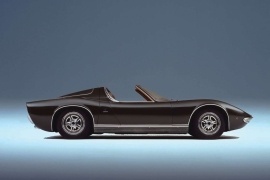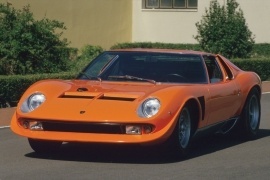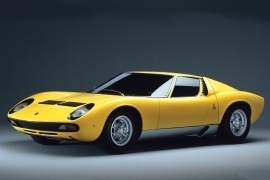
LAMBORGHINI Miura
Generations Timeline, Specs and Pictures

The Miura Roadster was a concept-car built by Bertone and showcased by Lamborghini at the 1968 Brussels Motor Show.
Considered the first supercar with a central-mounted engine, the Miura was designed by the Lamborghini engineers against the principles of the company’s founder, Ferruccio Lamborghini. Ferruccio was rather a fan of Gran Turismo. The first prototype, the P400, was revealed by the end of 1965, while the first Miura was unveiled in March 1966, and it was showcased at the Geneva Motor Show without an engine inside because it didn’t fit. It was a miscalculation, but in the end, all went well, and the carmaker managed to install the transverse engine inside.
Bertone considered that the Miura should be offered as a roadster as well and built a prototype, which Lamborghini showcased. While it was more of a targa than a proper roadster, it gathered media and customer attention. But Ferruccio didn’t want to build the open-top version.
The interior was simple, specific to the 60s, with a low seating position and a 3-spoke steering wheel. Its center console was tall and wide, even though there wasn’t used as a transmission tunnel. Like most of the concept cars, the Miura Roadster featured a leather-wrapped interior with high-bolster seats. The same expensive materials were used for the door panels, while the floor was carpeted with a thick cloth.
Bertone installed the same dashboard for the instrument panel as the one from the coupe version, but with special attention to the details.
Bertone installed the most powerful Lamborghini engine available at that time, the 4.0-liter V12. This time, it took its time to make the calculations and fit it better. It was paired to a five-speed manual gearbox.

The Miura is considered the first modern supercar of all times, and Lamborghini dared to make it as a series product, even though it was imagined only as a concept-car.
Marcello Ghandini was only 22 years old, and he was working for the Bertone Studios when he designed the Miura. Four years later, the carmaker modified the car to fit into the FIA’s Appendix J racing regulations. That led to several modifications, which made the Miura even faster, and the project was named Jota.
The Miura’s shape looks like the wind sculptured it from a block of ice. Its waved shapes over the front wheel-arches were repeated over the rear ones. Its only design flaw was that it tended to take-off at higher speeds from the aerodynamic point of view. To fix that, the team that worked on the SV/J changed the front of the car. They installed fixed headlights under clear lenses and an integrated spoiler profiled to increase the front axle’s downforce. After presenting the prototype and receiving the FIA approval, Lamborghini used some modifications to build the SV/J version in 1971 based on the Miura SV.
Inside, it was cramped, and two people could barely sit inside due to the limited headroom. The low seating position and the tall center console made things even more difficult. There was no radio in it. The transversely mounted V12 engine behind the cabin was loud enough to cover anything else. It was a screaming, 3.9-liter unit that could rev up to 8,000 rpm. The five-speed manual gearbox on the SV version was enhanced and allowed quicker and more precise gear shifts. As for performances, a 4.2 second for 0 to 62 mph (0-100 kph) was astonishing for those times. Even four decades later, it was still a respectable time.

Produced between 1966 and 1973, the Lamborghini Miura was the fastest street sports car produced at that time.
Considered the first supercar, with the central-mounted engine, the Miura was designed by the Lamborghini engineers against the wish of the company’s Founder, Ferruccio Lamborghini. Ferruccio was rather a fan of Gran Turismos.
The first prototype, the P400, was revealed by the end of 1965, while the first Miura was unveiled in March 1966.
Possibly one of the most beautiful cars even made, the Miura as initially limited to 30 units, however, Ferruccio had to reconsider his decision due to the high demand.
The interior was simple, specific to the 60s, with a low seating position and a 3-spoke steering wheel.
The center console was tall and wide and that was uncommon for the time.
The cabin was equipped with 6 gauges that displayed the engine temperature, fuel, oil pressure and others.
The door panels, the dashboard and the seats were covered in leather, and the floor had a soft carped.
The Miura ran on a 3.9-liter V12 engine that was also used for the previous 350GT and the 400GT. The engine cranked out 350 hp and 300 pound-feet of torque and was mated with a 5-speed manual transmission. The 0 to 100 km/h took around 6.3 seconds.
Despite the high price, Lamborghini managed to sell around 275 units in 3 years.























































